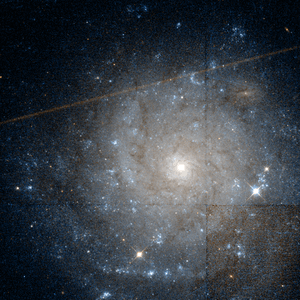NGC 1058
 | |
| NGC 1058 imaged by the Hubble Space Telescope | |
| Credit: NASA/ESA | |
| Observation data Epoch J2000 | |
|---|---|
| Constellation | Perseus |
| Right ascension | 02h 43m 30.24s[1] |
| Declination | +37° 20′ 27.2″[1] |
| Apparent dimension (V) | 3.801 x 3.715 moa[1] |
| Apparent magnitude (V) | 11.82[2] |
| Characteristics | |
| Type | SA(rs)c[2] |
| Astrometry | |
| Heliocentric radial velocity | 518 ± 1[2] km/s |
| Redshift | 0.001728 ± 0.000003[2] |
| Galactocentric velocity | 629 ± 5[2] km/s |
| Distance | 27.4 ± 4 Mly (8.40 ± 1.23 Mpc) |
| Other designations | |
NGC 1058 is a Seyfert Type 2 galaxy in the NGC 1023 Group, appearing in the Perseus constellation. It is approximately 27.4 million light years from Earth and has an apparent magnitude of 11.82. It is receding from Earth at 518 kilometers per second (322 mi/s), and at 629 kilometers per second (391 mi/s) relative to the Milky Way.
References
External links
- NGC 1058 on WikiSky: DSS2, SDSS, GALEX, IRAS, Hydrogen α, X-Ray, Astrophoto, Sky Map, Articles and images
Coordinates: ![]() 02h 43m 30.24s, +37° 20′ 27.2″
02h 43m 30.24s, +37° 20′ 27.2″
This article is issued from Wikipedia - version of the 11/30/2016. The text is available under the Creative Commons Attribution/Share Alike but additional terms may apply for the media files.